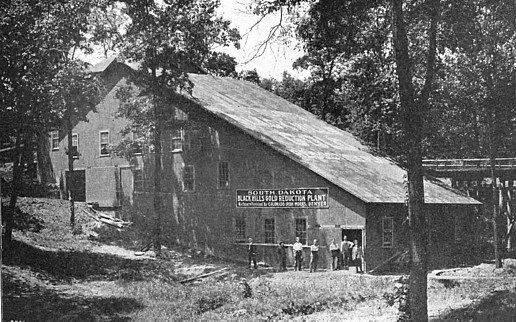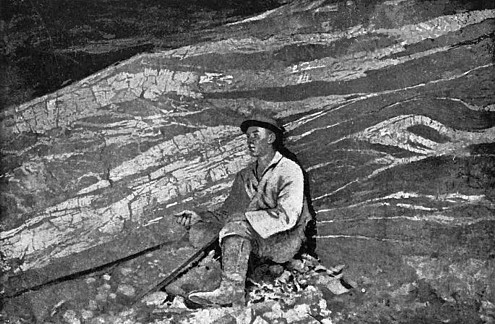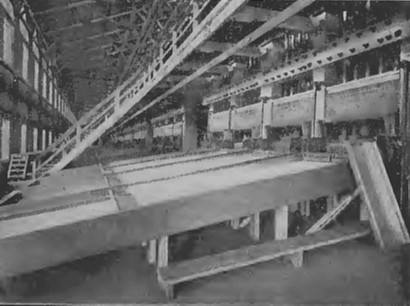Quartz mining and prospecting in the Black Hills appears to have begun almost simultaneously with placer mining. During the year 1876 many locations were made. The "Father Desmet" mine was discovered in May, and the "Sir Rhoderic Dhu" on the 23d of October following. Very soon afterward the " Homestake," and most of the other best known mines. Subsequently, the great size of the veins becoming known, as development progressed, a general interest in quartz prospecting was the result, and hundreds of locations were soon made. The first quartz-mill dropped its stamps on January 1st, 1877, and was built by Robert Lorton an M. E. Phinney. It was a custom-mill. Another class of gold deposits besides true veins began to be developed, known as cement deposits, and were found to be exceedingly rich. In February, 1877, the "Reno" mine, of this class, was discovered by L. G. Turner, A. Sawdry and A. L. Louden, near Central City. Within one short year some four thousand dollars or more were produced from the mine, all of which was pounded out of the rock in a common hand-mortar, and washed out in an ordinary prospecting-pan. The ore for a time was valued at fifty dollars per ton, and the owners were offered one hundred thousand dollars in gold for the property, and refused it. A single ounce of ore from this mine yielded three dollars and fifty cents, and one and a half pounds of rock, crushed with a sledge-hammer, yielded the astonishing sum of sixteen dollars. These were selected specimens, and of course not a fair test of the whole deposit, but it all added to the interest and gold rush excitement in quartz mining at that time. The Reno produces now about eight thousand dollars per month. The other cement mines best known are the "Great Eastern," which produces about seven thousand dollars per month (and which claims to have struck a true vein in one of its shafts) .
The "Aurora Consolidated," which puts out about seven thousand five hundred dollars, and the "Gustin," producing about one thousand two hundred dollars monthly. The gold ore from these mines are treated like that taken from true veins, being crushed in stamp-mills and amalgamated. From the vicinity of Deadwood Gulch miners extended their operations to other localities, and soon everywhere, all over the Black Hills, within a radius of seventy miles, very promising locations were made. Up to May, 1879, over four thousand seven hundred locations of quartz mines had been recorded, and new discoveries have been reported almost daily ever since. The Great Belt: The oldest and best-known mines are situated on what is termed "the Great Belt," a mammoth lode of several miles in length, situated between and extending from the. vicinity of Central City on the north, south to Lead City. The vein is of enormous width from forty to one hundred and fifty feet in various places, and continuous in length several miles. The Country Rock, of which the mountains through which it passes is formed, is a mica slate, one of the older or primary rocks, which here has been thrown up on its edge, the lines of its stratification bearing at an angle of fifty or sixty degrees from the horizontal. Between these lines of stratification have been formed great fissures, which have been filled with vein matter in solution, forming the lode described.
It is not our purpose to discuss the theory as to how these gold quartz veins were formed. Professor Jenney, of whom mention has been made, holds that these are true fissure veins. Interlaminated fissures, that is, fissures opened between the layers of the rock, and not across the line of stratification, as is frequent in other localities. The auriferous quartz, he says, has been formed by water solutions, which have come up from below ; and believing them to be true fissures, he supposes them to extend into the earth to an indefinite distance, and that they will increase in richness with depth. Other scientific men claim that they are not true fissures, but merely deposits formed in aqueous solution with oxide of iron, and precipitated between the walls of the rock while it was still in a horizontal position before its final upheaval to its present nearly perpendicular position. If the latter theory be correct, the veins will of course be liable to become much sooner exhausted than if the theory of Professor Jenney be right. But, allowing either theory to be correct, the amount of good ore in sight is immense, and it will take many years to- exhaust the apparent supply now opened up.
The great mines of the Black Hills, as known at present, are mostly on this "Great Belt," described above. Other districts may become in time fully as well known, and will undoubtedly prove as rich, but we have only space to describe those best known at present. "The Belt" extends in a northerly and southerly direction some distance west of Deadwood, and from north to south. It is something over two miles in length. In several places this great lode is proved to be fully one hundred feet wide, and in others nearly twice as wide. Beginning on the north end of the lodes, the first mine fully proved to be on "The Belt," is the "Father Desmet." However, the "Sir Rhoderic Dhu," a valuable mine just north, is believed by many to be on the same great vein, and in time may prove to be so in fact. The Desmet mine is owned by Messrs. Archie Borland, August Hemme, L. R. Graves and A. J. Bowie, Jr., all of California. The ground owned by them comprises three claims, "Father Desmet," "Golden Gate" and "Justice." The claims all being three hundred feet wide by one thousand five hundred feet in length on the lode, but two of the claims (the Desmet and Golden Gate) lying parallel to each other, forming a parallelogram six hundred feet wide by one thousand five hundred feet long. The owners of these three claims only have a total of three thousand feet in length on the Belt. It is probable that separate organizations or stock companies will be formed to work each of these claims. The Desmet is now producing about sixty-one thousand dollars per month, and has large mills in course of erection. The ore averages about twelve dollars per ton by mill process, and the claims cost the owners four hundred thousand dollars, which is the highest price paid for any claim or set of claims in the Black Hills.
The Deadwood Mine.
South of the Desmet group is the " Deadwood" mine, which is owned by Messrs.
Lloyd Tevis, J. B. Haggin, George Hearst and Gilmer, Salesbury & Co. The
claim comprises something over one thousand feet on the lode. The company
have an eighty
stamp mill, which produces about forty-five thousand dollars per
month. The expenses per month being only about eight thousand dollars, the
company is making a net profit of nearly thirty-seven thousand dollars
monthly. South of the Deadwood mine is the "Golden Terra" claim, of five
hundred feet on the Belt. It has two stamp-mills, one of twenty and another
of eighty stamps. The product of the mine is about sixty thousand dollars
per month. Lying next south is the "Highland" mine (which is sometimes
called the " Homestake, No. 2"). It comprises four claims, the shortest one
being eight hundred feet long. It is owned by Messrs. Tevis, Haggin &
Hearst, and Gilmer, Salesbury & Co., and cost them two hundred and fifty
thousand dollars. It is building a one hundred and twenty stamp mill, which,
when it is completed, will produce about seventy thousand dollars per month.
The present product is fifteen thousand dollars per month.
Lying south of the Highland, is the Homestake, which owns two claims, the Homestake and Golden Star, each of which is one thousand five hundred feet long by three hundred feet wide. It is an incorporated company, its shares selling on the market at all the exchanges, and cost seventy thousand dollars for the Homestake claim and fifty-five thousand dollars for the Golden Star. It has two mills, one of eighty and one of one hundred and twenty stamps, the latter, at the time of its erection, being the largest gold-mill in the world in the number of its stamps. The product of the mine is about one hundred and fifteen thousand dollars per month. The Giant and Old Abe, the next mine south, owns a strip of territory equal to one hundred and fifty feet long on the belt, by six hundred feet wide, and cost the corporation who bought it two hundred and fifty-two thousand dollars for all the conflicting interests. The mine is sufficiently developed to be safely called upon the belt, and is erecting a one-hundred-and-twenty-stamp mill. These locations comprise the mines known to be on the same great ledge, although, as stated, others may prove to have found the lode with depth after further exploration has been made. Among the valuable mines not on the belt, the Rhoderic Dhu produces about twelve thousand dollars per month; the Esmerelda, ten thousand; Durango, ten thousand; High Lode, thirty thousand; Gopher, ten thousand; Caledonia, which is a very valuable property, forty thousand per month. North of the Father Desmet mine, and south of the Homestake, the great mother vein seems to dip into the earth, and is apparently lost, although extensions are claimed to be found, and may become so, in fact, which further developments will have to demonstrate.
The Desmet Mine and
Mill.
The Desmet Mine, as originally purchased, comprised the Justice, Belcher
and Golden Gate, all lying parallel to the claim whose name now designates
all. The "Justice" was the first of these to make the acquaintance of the
prospectors' pick in 1876. The Desmet proper was opened by removing the
surface dirt from the ledge, which came to the surface in many places,
showing up a "face" of sixty feet of ore when the sale was made. The new
owners pushed their development from this breast, already exposed, finding,
when a wall was encountered, that the ledge was one hundred and fifty-four
feet across. An occasional barren boulder, or "horse," was met with, but
from this excavation twenty thousand tons of ore were extracted and milled,
which yielded an average of ten dollars per ton. Crossing the ledge, as
defined by the wall already exposed, a body, or chimney of rich quartz,
about four feet wide, paid eighty dollars per ton, probably the richest ore,
where any great quantity exists, yet found in the Hills. The mountain has
been penetrated by a drift for a distance of four hundred feet to a point
near its centre, and the same character of ore (not, however, this
eighty-dollar ore) is found. Crosscuts at different places along the line of
this drift prove the ledge to be at no point narrower than seventy feet,
while the greater portion of it is much wider. The mountain side being very
steep, drifts four hundred feet long penetrate a long distance below the
surface, and as the overlying mass in this instance is known to be chiefly
ore, the quantity in sight above this drift will be readily comprehended as
immense. It is asserted that the vein of ore showing up in the Desmet, and
from this mine through to the Homestake, a distance of one and one-fourth
miles, is the largest vein of ore yet found in the world, when its great
width is taken into consideration. The course of the ledge is slightly
south-west and south-east, with a dip to the east of about thirty-five
degrees.
At the surface-opening near the "Belcher," the quartz is one hundred and fifty feet in width, with ore beyond. The vertical shaft of the "Justice" is down in ore one hundred and seventy-five feet; thence by winze of one hundred and forty seven feet to a tunnel, where the ore from the upper workings is dumped into cars, and transported along the tunnel three hundred and forty feet to an automatic elevator, situated about forty feet from the mouth of the tunnel. The cars are there lowered on the elevator to an enclosed tramway, running direct to the mill. The tramway is two hundred and eighty-one feet long, and crosses from the hillside to the mill with a span of over forty feet in length, and is at an elevation of seventy feet from the surface. At the end of this tramway the cars are emptied into rock breakers, and thence, by means of chutes, runs to the bins, from which it is fed to the stamps. The eighty stamp mill is perfect in all its arrangements. The principal work on the mine is now confined to the two-hundred-and-fifty-feet level. Here an immense chamber, over one hundred feet square, has been excavated, the south-west side showing the foot wall of the vein. The breast of ore exposed is over one hundred feet wide, hard and firm in its character, impregnated with white iron, and mills well in gold. The ore has very little waste intermixed with it, and averages from twelve to twenty dollars per ton.
Return
to The South Dakota Page:
South Dakota Gold Rush History




